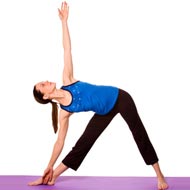- Aromatherapy (36)
- Benefits of Yoga (282)
- Home Remedies (1087)
- massage therapy (9)
- Preventive Therapy (135)
- Running (41)
- Skin Care (15)
- Stress Relief (25)
- Stretching (5)
- walking (33)
- Womens Health (14)
- Yoga Benefits for Pregnant Women (16)
- Yoga Benefits for Students (3)
- Yoga for Children (11)
- Yoga for Holistic Living (37)
- Yoga for Midlife Crisis (3)
- Yoga for Senior Citizens (2)
- Yoga for the Workplace (1)
- Yoga Health Tips (185)
- Yoga Practice during Menstruation (5)
Preventing Pain Caused By Osteoporosis Through Yoga

Osteoporosis is a progressive bone disease characterized by structural atrophy of bone tissue and low bone mass. This causes brittleness of the bones and, subsequently, greater susceptivity to fractures, particularly of the wrist, spine and hip, even though any bones could be affected. Hence this is also called porous bone disease.
Over 44 million Americans are said to be afflicted by low bone mass, which is 55% of those over the age of 50. Further, Osteoporosis is the cause of over 1.5 million fractures every year. It endangers around 200 million people all over the world. Many of them have neither the resources nor access to medication.
Yoga has been known to be highly effective in treating Osteoporosis. By opposing different muscle groups over fairly long periods of time, Yoga has proven to be a fantastic stimulus for this sort of bone support. This is a self-administered, so it can easily be manipulated to create forces that are strong enough to stimulate bone reinforcement, but without damaging the bones you are trying to strengthen!
There are a number of yoga techniques for the knees and we feel you should practice them regularly to help ease the pain and kick-start the healing process. This method could take about three months to deliver results but it will definitely be a permanent solution and will help you in the long run.
Seven Yogic Ways To Protect The Knees
Avoid extending too much
Already overly mobile joints, when flexed too far back, tend to get hyper-extended. Hyper extension often happens in the knees, in asanas (poses) such as Trikonasana (Triangle Pose) and Paschimottanasana (Seated Forward Bend). In these poses, you require to straighten your legs, thereby putting an unsafe tension on your ligaments. So, when doing seated forward bends, keep a rolled-up towel or sticky mat below the knee of your stretched legs.
Always begin with your feet
Right alignment through your feet is fundamental to building strength uniformly in your ligaments on either side of your knees. So, in every asana (pose), including inversions spread out your toes and press firmly through all four corners of the feet.
Keep your knees aligned
When you move into deep knee-bends, like Parsvakonasana (Side Angle Pose) and Virabhadrasana II (Warrior Pose II), first see that your bent knee is aligned over your ankle. While you lift up from the instep of the front foot, see that your back foot, presses down squarely.
Listen to the subtle signals
Very often, your knees may not give you immediate feedback. You come to realize that you've stretched too far only later when it may be too late and the damage is already done. So, if you feel ache when coming of a bent-knee pose, it means that you have worked too hard.
Build strength through balances
Balances, particularly those like Garudhasana (Eagle Pose), that call for moving through a bent standing leg, are very helpful. By training the structural alignment, these dynamic balances help protect your knees against future injuries.
Don’t hesitate to use props
In seated asanas (poses), such as Virasana (Hero Pose), Marichyasana III (Pose Dedicated to the Sage Marichi III) or Balasana (Child's Pose), nothing gives your tight knee at such an advantage as the use of props. Try and raise your seat with a block or blankets in these asanas.
Never skip your warm-ups
A lot of yoga practitioners tend to harm their knees doing asanas (poses) before they’re ready. If you start asana practice without opening the joints, you will be putting too much stress on your small joints. So always warm up sufficiently with hip stretches such as Gomukhasana (Cow Face Pose) and Baddha Konasana (Bound Angle Pose).
Suggested Asanas (Poses For The Knees)
- Single and Double Leg Raises
- Parsvakonasana (Side Angle Pose)
- Virabhadrasana II (Warrior Pose II)
- Pavanamuktasana (Wind Relieving Pose)
- Stand Spread Leg Forward Fold
- Bhujangasana (Cobra Pose)
- Paschimottanasana (Seated Forward Bend).
- Garudhasana (Eagle Pose)
- Salabhasana (Locust Pose)
- Virasana (Hero Pose)
- Marichyasana III (Pose Dedicated to the Sage Marichi III)
- Balasana (Child's Pose)
- Shavasana (Corpse Pose)
- RSS Feeds -
- All posts
- All comments
- Back Pain and Massage Therapy Back pain is one of the most common complaints in this day and age. Back pain...
- How to Prevent Hip Flexor Pain While Running Pain in the hip or pelvic region is a common occurrence amongst runners, espe...
- Exercising after menopause Exercising after menopause As you age, you may feel that maintaining...
- Controlling Qi with or without Needles According to Traditional Chinese Medicine (TCM), the ‘Qi’ or ‘...